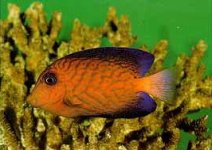I think we need to talk about this one some more.
I'm not so sure that the Chevron tang really does mimic the Potter's angel. If it does, it is doing a crummy job compared to the true Mimic tangs (
Acanthurus pyroferus &
tristis).
The Chevron only sorta looks like the Potter's. The closer you look the worse the mimicry is. The Potter's has defined vertical squiggly lines while the Chevron has randomish squiggly lines that approximate a chevron in their overall pattern, but with a horizontal bias. The angel also has a center body shading (that is sometimes very dark) that is completely missing in the tang. The tang has a very dark top and bottom but the angel really doesn't. The angel's tail is dark, but the tang's isn't. The angel's finnage is more rounded while the tang's fins taper off. It's a crappy mimic when you compare it to the almost ridiculous perfection of the true Mimic tangs.
Further, the geographic range of the Chevron tang is fairly widespread (though I think it is uncommon everywhere) while the Potter's angel is restricted to Hawaii. The Chevron looks the same everywhere it's found. IOW, if the tang is mimicking the angel, it is doing so even many thousands of miles away from where the angels are found. The Mimic tangs however, mimic the
Centropyge angels that they live with.
Classic Batesian mimicry proposes that if you can look like something dangerous or toxic, animals will avoid you that would otherwise eat you. But it seems that mimicry can get you more benefits than just that, and the tang mimicry may have multiple benefits.
By not looking like adult tangs, the juveniles might avoid territorial conflicts with adults and therefore live amongst them 'unnoticed'. But that would suggest that juvenile tangs would be able to look like
anything other than an adult to avoid this conflict. So why look like an angel?
By looking like an angelfish, the tang might avoid some of the relentless aggressive protection of algae done by damsels. Damsels hate tangs with a passion because tangs are out to eat their precious algae patch that they guard violently. The angels might be more tolerated by the damsels, allowing the juvenile tang to avoid this aggression until it gets large enough to deal with it.
It may be that the juvenile tangs avoid being eaten by pred
ators because they look like an angelfish. It's been proposed that this might be because the angels have cheek spines that they can erect and use in defense. The spines might create such a hassle for fish trying to swallow an angel that they just avoid them entirely. But the tang has erectile spines (bladelike) of its own at the base of the tail.
Maybe
Centropyge angels are mimicking juvenile tangs :wink:
I will say the same about the wrasse. It's color only approximates the angel. There is no shading with the wrasse and it's another crappy attempt if it really is one. Ichthyologists have not mentioned it mimicking the angel (nor have they mentioned the Chevron mimicking the angel) and they also do not call it a
Potter's Wrasse. AFAIK, only certain people in the aquarium trade call this wrasse a Potter's wrasse. It's not even listed as one of the known common names in FishBase.
Maybe the mimicry is good enough to work even as crude as it is. But it still would beg the question of why the true Mimic tangs are a perfect replica of the
Centropyge angels, if crudeness will work.
There was a good earlier thread on the Mimic tangs here:
http://reefs.org/phpBB2/viewtopic.php?t=35313






